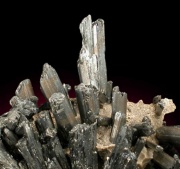Antimony trisulfide
Description
1) A red pigment that is also called antimony vermilion. Antimony trisulfide was first synthesized in 1842 by C. Himly. Depending on conditions, the pigment can range in hue from orange to deep red. It is an unstable crystalline form and turns black when mixed with lead pigments. Antimony vermilion is also used to color ruby glass. See also antimony oxide sulfide.
2) A black pigment that is prepared by grinding the mineral stibnite. Antimony sulfide, is actually antimony trisulfide, but because it exists as red (synthetic) and black (natural) crystals, the black form is sometimes called antimony sulfide and antimony black. Black antimony trisulfide is used in camouflage paints because it has the same infrared reflectance value as green foliage. The black powder, called kohl, was occasionally used as an eye paint in Egypt from the Amarna period onwards (Ogden 2000). Antimony black powder was used since the late 17th century to blacken the edges of books (Roberts and Etherington 1982).
Synonyms and Related Terms
antimony (III) sulfide; antimony sulfide; stibnite (mineral); antimony trisulphide (Br.); orangé d'antimoine (Fr.); trisulfure d'antimoine (Fr.); sulfure d'antimoine (Fr.); Antimontrisulfid (Deut.); Stibnit (Deut.); Antimonit (Deut.); trisulfuro de antimonio (Esp.); tritheioycho antimonio (Gr.); trisolfuro di antimonio (arancio di antimonio) (It.); antimoon trisulfide (Ned.); trisulfureto de antimónio (Port.); antimony orange; antimony red; antimony vermilion; antimony black; hermus mineral
Other Properties
Soluble in alkalis and strong acids. Insoluble in water.
| Composition | Sb2S3 |
|---|---|
| CAS | 1345-04-6 |
| Melting Point | 546 |
| Density | 4.562 |
| Molecular Weight | mol. wt. = 339.72 |
| Refractive Index | 2.65 |
Hazards and Safety
Skin contact can cause allergies and ulcers. Reacts explosively with organic materials. Highly toxic by inhalation and ingestion.
Turns black with heat or when mixed with lead pigments.
Fisher Scientific: MSDS 05/02/01
Additional Information
° M.Roberts, D.Etherington, Bookbinding and the Conservation of Books: a Dictionary of Descriptive Terminology, U.S. Government Printing Office, Washington, DC, 1982.° J. Ogden, "Metals" in Ancient Egyptian Materials and Technology, P.Nicholson, I.Shaw (eds.), Cambridge University Press, 2000, p. 149.
Authority
- G.S.Brady, Materials Handbook, McGraw-Hill Book Co., New York, 1971 Comment: p. 64
- R. J. Gettens, G.L. Stout, Painting Materials, A Short Encyclopaedia, Dover Publications, New York, 1966
- Ralph Mayer, A Dictionary of Art Terms and Techniques, Harper and Row Publishers, New York, 1969 (also 1945 printing)
- Susan E. Schur, Conservation Terminology: A review of Past & Current Nomenclature of Materials, Technology and Conservation, Spring (p.34-39); Summer (p.35-38); Fall (p.25-36), 1985
- Michael McCann, Artist Beware, Watson-Guptill Publications, New York City, 1979
- Art and Architecture Thesaurus Online, http://www.getty.edu/research/tools/vocabulary/aat/, J. Paul Getty Trust, Los Angeles, 2000

